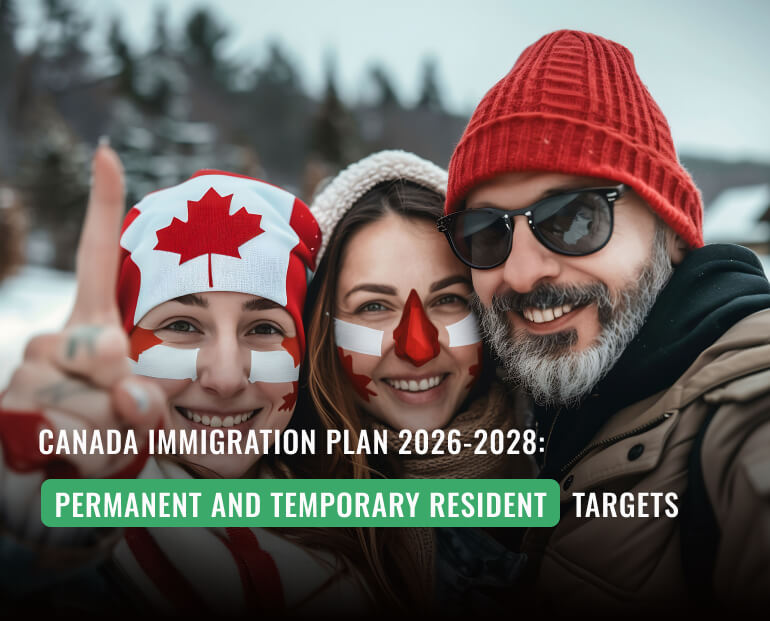The Canadian government announced new immigration goals for the years 2026 to 2028. The goal of this policy change is to keep the number of permanent residents coming in steady. Over the next three years, there will be a huge drop in the number of temporary residents who are allowed to stay.
The plan is a response to the growing stress on important services and infrastructure across the country. Schools, hospitals, and the housing market have had a hard time keeping up with recent growth. The government wants to keep the number of people coming in steady while also meeting the needs of the economy.
Goals for Permanent Resident Admission
Canada will keep its permanent resident target stable throughout the plan period. For three years in a row, the goal for annual admissions has stayed the same at 380,000.
Permanent resident admissions: 380,000 a year from 2026 to 2028
Permanent Resident Goals for Each Year:
| Year | Total PR Admissions | Change from 2025 | Annual Growth Rate |
|---|---|---|---|
| 2025 | 395,000 | Baseline | ~1% population growth |
| 2026 | 380,000 | 4% decrease | <1% population growth |
| 2027 | 380,000 | 4% decrease | <1% population growth |
| 2028 | 380,000 | 4% decrease | <1% population growth |
Are you having trouble with your application to move to Canada from Oman? DM Consultants is an expert in helping people apply for skilled worker visas to Canada, Australia, the UK, and the US. We take care of all the paperwork, such as getting a visa and a work permit.
Permanent Resident Distribution by Category
Immigration based on economic class now makes up the biggest part of permanent admissions. Under the new framework, the allocation went up from 59% to 64%.
Distribution of Permanent Residents by Category:
| Immigration Class | 2026 Admissions | % of Total | Key Details |
|---|---|---|---|
| Economic Class | ~240,000 | 64% | Skilled workers, business migrants, PNPs |
| Family Class | ~84,000 | 22% | Spouses, partners, parents, children |
| Humanitarian Class | ~56,200 | 14% | Refugees and protected persons |
| Total | 380,000 | 100% | Consistent 2026–2028 |
Breakdown of Economic Classes:
- Skilled workers: Skilled workers make up the biggest group of the 240,000 jobs.
- Provincial nominees: Provinces get more money to meet their regional needs.
- Business migrants: Entrepreneurs and investors are part of the economic goals.
- French speakers: Going from 9% of all admissions in 2026 to 10.5% in 2028.
“French-speaking immigrants outside of Quebec: 30,000 to 35,000 a year by 2028”
Cuts to Temporary Resident Admission
The plan cuts costs by a lot for all types of temporary residents. Every year, there are big drops in the number of work and study permits.
“Goal for the temporary resident population: Less than 5% of Canada’s total population by 2027”
Three-Year Goals for Temporary Residents:
| Year | Total TR Admissions | Work Permits | Study Permits | Change from 2025 |
|---|---|---|---|---|
| 2025 | 673,650 | 367,750 | 305,900 | Baseline year |
| 2026 | 385,000 | 230,000 | 155,000 | 43% reduction |
| 2027 | 370,000 | 220,000 | 150,000 | 45% reduction |
| 2028 | 370,000 | 220,000 | 150,000 | 45% reduction |
What does it mean to reduce study permits?
Starting in 2026, the number of international students who can get in will drop by half. The government wants to control how many students come in so that it matches the current capacity of schools.
Goals for Study Permits:
- 2025 level: 305,900 permits were given out in 2025.
- 2026 target: 155,000 permits (50% less)
- 2027–2028: 150,000 permits a year from 2027 to 2028.
Purpose: Ease the pressure on campus and housing resources.
Are you feeling overwhelmed by all the forms, credentials, and paperwork? DM Consultants carefully reviews your education and work experience. Our team checks credentials and ensures that applicants to Canada as skilled workers follow the rules.
Changes to Work Permits and Priorities
Overall, the number of work permits issued goes down by about 37% to 40%. The focus moves to jobs that require a lot of skill and areas where there aren’t enough workers.
Annual Goals for Work Permits:
- 2025 baseline: 367,750 new permits.
- 2026 allocation: 230,000 permits.
- 2027–2028: 220,000 permits per year.
- Priority areas: Healthcare, technology, engineering, and trades in high demand.
“Low-wage work permits will have stricter rules; high-skill immigration will be encouraged.”
Ways to go from temporary to permanent resident
The government set up two big programs to help people move to new jobs in 2026 and 2027. These programs help people who are already living in Canada temporarily get permanent status faster.
Programs for Transition Pathways (2026–2027):
| Program Type | Total Allocation | Eligible Applicants | Key Criteria |
|---|---|---|---|
| Work Permit Holders | Up to 33,000 | Current work permit holders | Skilled jobs, long work history, in-demand roles |
| Protected Persons | ~115,000 | Refugees and claimants in Canada | Cannot return home safely, established in Canada |
| Total TR to PR | ~148,000 | Over 2 years | Priority processing for both streams |
Pathway for Work Permit Holders
Up to 33,000 people with valid work permits get priority processing for permanent residence. This program is for workers already helping Canada’s economy.
Focus on Eligibility:
- Current status: Valid work permits at the time of application.
- Work history: Long Canadian work history.
- Skill level: High-demand jobs get first choice.
- Tax contribution: Workers paying into the Canadian tax system are prioritized.
Program for the Integration of Protected Persons
About 115,000 eligible refugees and claimants get permanent resident status. This two-year program helps people who can’t safely return home.
Information about Protected Persons:
- Total allocation: 115,000 (2026–2027).
- Eligible groups: Convention refugees and claimants in Canada.
- Rationale: Considers established community ties and long-term residence.
- Integration: Helps people who have built lives in Canadian communities.
More help with the transition
The plan includes measures to ensure smooth status changes and help people remain legal while their applications are processed.
Improvements to Application Processing:
- Bridging permits: Inland PR applicants can get open work permits.
- Processing speed: Faster processing for family and worker class applications.
- IRCC funding: More resources to improve services.
- Priority streams: High-demand workers get faster processing.
Support for the Region and the Economy:
- Provincial programs: PNPs get more funding to meet local labor needs.
- Skill retention: Engineers and scientists already in Canada are prioritized.
- Internal transition: Focus on converting temporary residents to permanent rather than new intakes.
- Balanced approach: Aligning immigration with available infrastructure and services.
Goals for French-speaking immigrants
More attention will be paid to French-speaking immigrants outside of Quebec through 2028. The percentage rises to support Francophone communities across Canada.
Goals for French Speaker Admission:
| Year | % of Total Admissions | Approximate Numbers | Target Communities |
|---|---|---|---|
| 2026 | 9.0% | ~30,000 | Outside Quebec |
| 2027 | 9.5–10% | ~32,000–33,000 | Francophone communities nationwide |
| 2028 | 10.5% | ~35,000 | French-speaking regions across Canada |
Important Things for Applicants to Know
- Permanent residence: Consistent targets give qualified candidates predictability.
- Economic class: More support for skilled workers and business migrants.
- Temporary permits: Fewer applications make the process more competitive.
- Transition programs: Temporary residents get more ways to become permanent.
- French advantage: French speakers benefit from higher admission targets outside Quebec.
Conclusion
The immigration framework in Canada from 2026 to 2028 shows a careful policy shift. Permanent immigration remains steady, supporting the economy and population growth, while temporary admissions decrease significantly to relieve housing and service strain.
The transition programs demonstrate that Canada values workers already contributing to their communities. For personalized help with your move to Canada from Oman, visit our website.

















